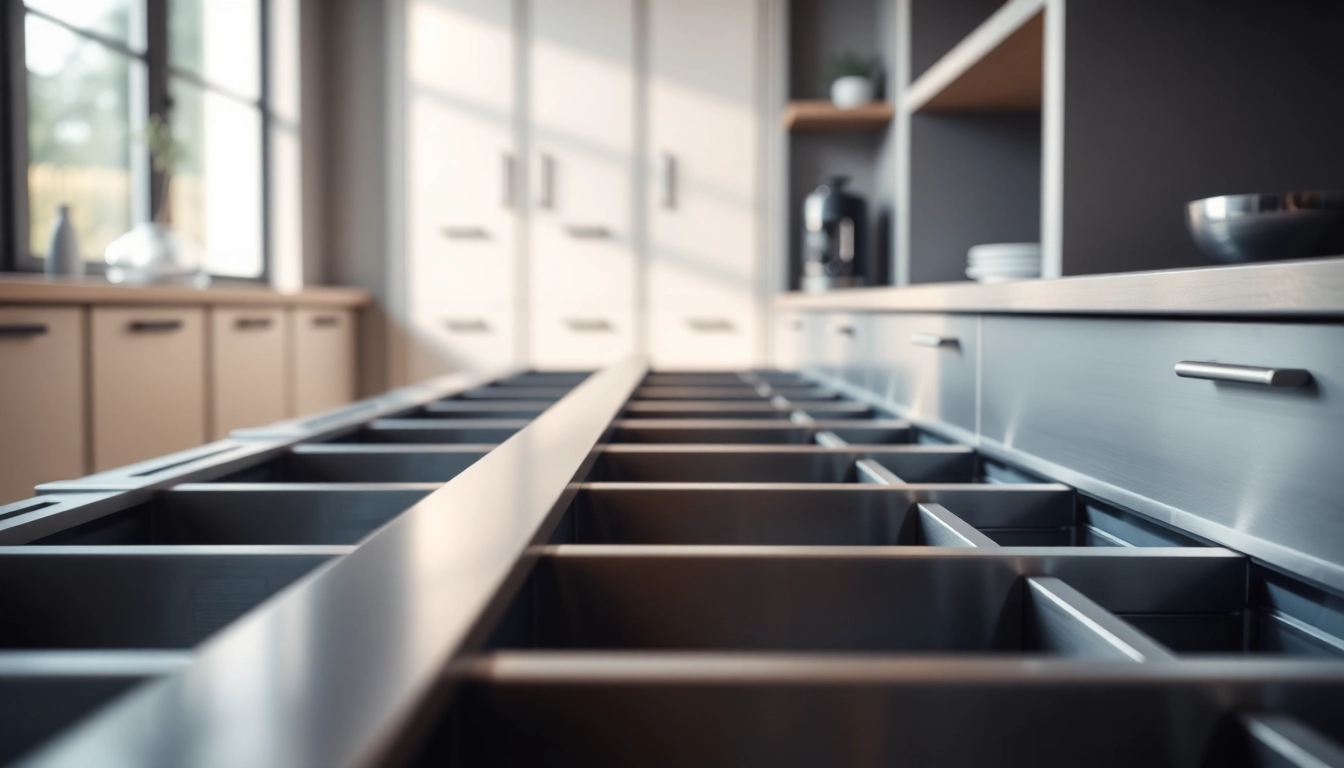Understanding Metal Drawer Systems
In the world of furniture construction and organization, metal drawer systems have emerged as a quintessential component that balances functionality with aesthetic appeal. Designed to cater to both residential and commercial needs, these systems provide critical storage solutions that are not only practical but also stylish. Whether you’re upgrading your kitchen, optimizing office spaces, or revamping your workshop, a well-selected Metal Drawer System can enhance both efficiency and aesthetics.
What is a Metal Drawer System?
A metal drawer system comprises various components designed for the seamless integration of metal drawers within cabinetry or furniture. These systems include drawer slides, brackets, and metal boxes that are engineered for durability and ease of use. Characterized by their robust construction, metal drawer systems can handle a significant amount of weight while maintaining a smooth operation. They are available in multiple styles to suit different applications, ranging from soft-close mechanisms to self-close functionalities.
Benefits of Using Metal Drawers
The advantages of opting for metal drawer systems are manifold. One of the primary benefits is their enhanced durability. Unlike wooden drawers that may warp or degrade over time, metal drawers are resistant to moisture, termites, and physical damage. Additionally, metal drawer systems often come equipped with advanced features, such as soft-close mechanisms, which prevent slamming and extend the lifespan of the system. Furthermore, they offer a sleek, modern appearance that elevates the overall design of any space. Another significant benefit is their ease of maintenance; a simple wipe-down with a damp cloth typically suffices for cleaning, allowing them to maintain their appearance with minimal effort.
Common Applications in Home and Industry
Metal drawer systems find their place across various sectors. In residential settings, they are frequently used in kitchens, bathrooms, and wardrobes, providing reliable storage for utensils, toiletries, and accessories. In commercial environments, office spaces benefit from metal drawers that organize supplies and paperwork efficiently. Additionally, industrial settings utilize these systems for tool storage, ensuring that heavy items can be stored safely and accessed easily.
Key Features of Metal Drawer Systems
Design Variability and Customization
Metal drawer systems are highly customizable, making them adaptable to various design contexts and personal preferences. Many manufacturers provide options for color finishes, drawer depths, and widths, ensuring that the drawers can fit seamlessly within existing cabinetry. Customization extends to accessories such as dividers, organizers, and soft-close mechanisms, allowing users to create a storage solution tailored to their specific needs. Furthermore, advancements in technology have enabled manufacturers to offer various aesthetic designs, from industrial chic to minimalist elegance, catering to diverse design palettes.
Durability and Material Strength
One of the standout features of metal drawer systems is their strength and durability. Typically constructed from high-quality steel or aluminum, these drawers can withstand significant wear and tear, making them ideal for both home and industrial use. Many systems are also coated with finishes that resist rust and scratches, further enhancing their longevity. This structural integrity means that even with heavy usage, metal drawers maintain their form and function over time, reducing the need for replacements.
Functionality: Soft Close vs. Self-Close Options
Selecting the right closing mechanism is crucial when choosing a metal drawer system. Soft-close drawers utilize hydraulic systems to slow down and gently close the drawer, preventing slamming and minimizing noise. This feature is particularly beneficial in family homes or quiet offices where abrupt sounds can be disruptive. On the other hand, self-close mechanisms automatically pull the drawer shut when it is pushed to a certain point. While they may not offer the same level of quietness as soft-close systems, self-close drawers are ideal for those seeking an efficient and straightforward operation. Understanding these options can help consumers choose a system that aligns with their lifestyle and usage patterns.
Selecting the Right Metal Drawer System
Factors to Consider in Your Choice
When evaluating metal drawer systems, several factors are essential to ensure that you select the most appropriate choice for your needs. First, consider the weight capacity required for your drawers. Assess what will be stored within them, as this will dictate the necessary durability and type of materials used. Second, evaluate the space available; measure the intended area to ensure that the drawers fit comfortably without impeding adjacent surfaces. Additionally, consider the aesthetic aspect; a drawer system that complements existing décor can enhance the overall visual appeal of your space. Lastly, assess installation requirements; some systems may be more user-friendly than others, requiring different tools or expertise levels.
Comparing Popular Brands: A Quick Guide
The market for metal drawer systems features several reputable brands, each offering unique advantages. For example, Blum specializes in high-quality, innovative drawer systems known for their smooth operation and durability. Häfele provides a broad array of drawer systems that blend functionality with elegance, suitable for both residential and commercial settings. Richelieu Hardware is another prominent player, offering a vast selection of customizable options. By comparing the specifications, features, and reviews of these brands, consumers can make an informed decision that aligns with their preferences and requirements.
Integration with Existing Furniture
Integrating a new metal drawer system with existing furniture can pose challenges, but several strategies can help ensure a seamless transition. First, assess the size and style of your current furniture; choosing a design that reflects or complements these elements can yield cohesion. If replacing existing drawers, measure carefully to ensure compatibility with the allotted space. Additionally, customization options may allow for modifications to match existing cabinetry perfectly. Finally, consult with professionals if necessary; a skilled carpenter can often help create a bespoke solution that fits your needs precisely.
Installation Tips for Metal Drawer Systems
Tools and Materials You’ll Need
Before diving into the installation of a metal drawer system, it’s vital to gather all necessary tools and materials. Common tools for this task include a power drill, screwdriver, measuring tape, level, and pencil for marking. Depending on the specific system, additional hardware such as sliding rails, brackets, and screws may be required. Always refer to the manufacturer’s instructions for precise requirements. Having everything ready ahead of time can minimize frustration and reduce the installation timeline.
Step-by-Step Installation Guide
Installing metal drawer systems can be greatly simplified by following a systematic approach. Here’s a step-by-step guide:
- Measure and Mark: Start by measuring the cabinet or furniture space where the drawers will be installed. Use a level to mark where the tracks will be aligned, ensuring symmetry for a professional finish.
- Install Drawer Slides: Follow the manufacturer’s instructions to attach the drawer slides to the sides of the cabinet. Ensure they are secured at the height marked earlier and double-check alignment.
- Attach Drawer Box: Once the slides are fixed, carefully place the metal drawer box onto the slides. Ensure it fits snugly into the designated position.
- Test the Mechanism: Open and close the drawer to test the mechanism, making sure it operates smoothly and aligns properly.
- Finish Up: Secure any additional hardware as needed and check all connections to ensure they are tight and secure.
While these steps provide a general guide, always refer to the specific instructions provided with your drawer system for the best results.
Common Mistakes to Avoid
Installation can be straightforward, yet several common mistakes can lead to complications. One frequent error is miscalculating measurements, resulting in drawers that don’t fit properly. Always measure twice before cutting or drilling. Another mistake is overlooking weight capacity; ensure that the selected system can handle the intended weight load to prevent premature failure. Lastly, rushing through installation can lead to missed steps or improper alignment; take your time to ensure accuracy throughout the process.
Maintaining Your Metal Drawer System
Cleaning and Upkeep for Longevity
To maximize the lifespan of your metal drawer system, regular maintenance is crucial. Start by wiping down the exterior surfaces with a damp cloth to remove dust and debris. For the slides, lubricating them occasionally with a silicone-based spray can prevent rust and ensure smooth operation. Avoid using harsh chemicals that may damage the finish or mechanisms. A comprehensive cleaning every few months will also help to maintain functionality and aesthetics, keeping your drawers looking and performing like new.
Adjustments and Repairs: A Quick Reference
Despite their durability, metal drawer systems may occasionally require minor adjustments or repairs. Common adjustments involve tightening screws or realigning slides if the drawer doesn’t open or close smoothly. If a slide gets damaged or the drawer becomes misaligned, often, simply re-seating the drawer or replacing the affected hardware can resolve the issue. For significant repairs, consult the manufacturer’s guidelines or consider seeking professional assistance to ensure the system is restored effectively.
Performance Metrics: When to Replace
Knowing when to replace a metal drawer system can save you time and money in the long run. Monitor for signs of wear such as difficulty in opening and closing, visible damage to the metal, or structural weaknesses. If adjustments no longer resolve these issues or if the drawer fails to support its intended load, it may be time for a replacement. Regularly assessing performance can help you avoid any sudden failures and ensure your storage solutions remain effective and reliable.



